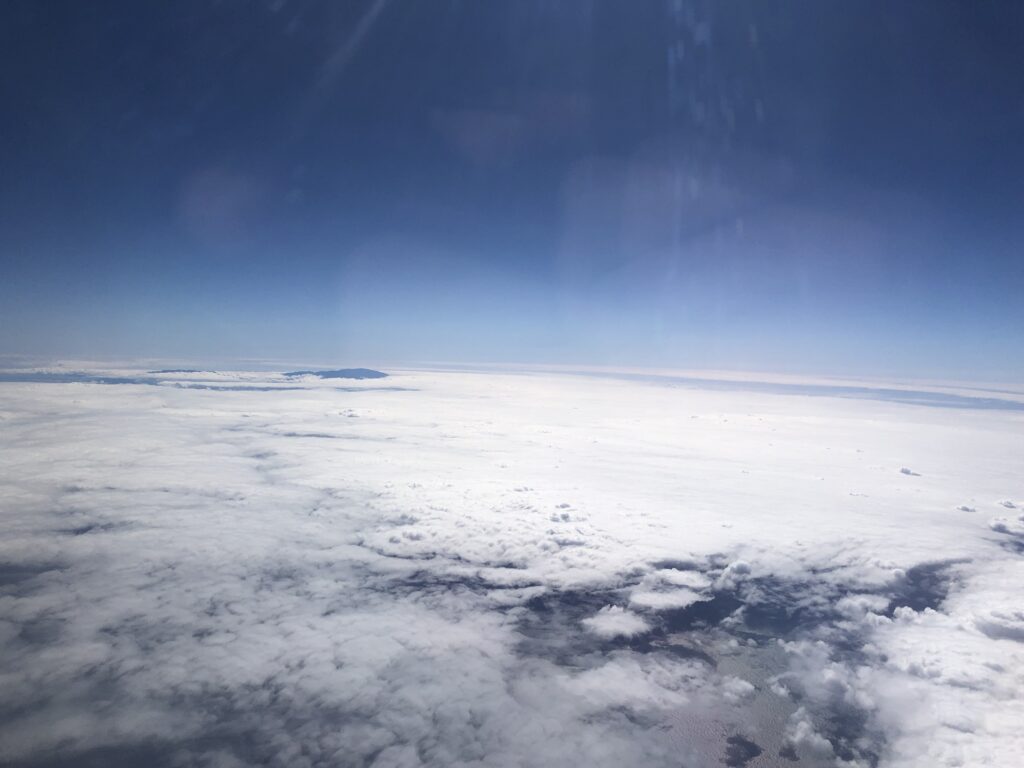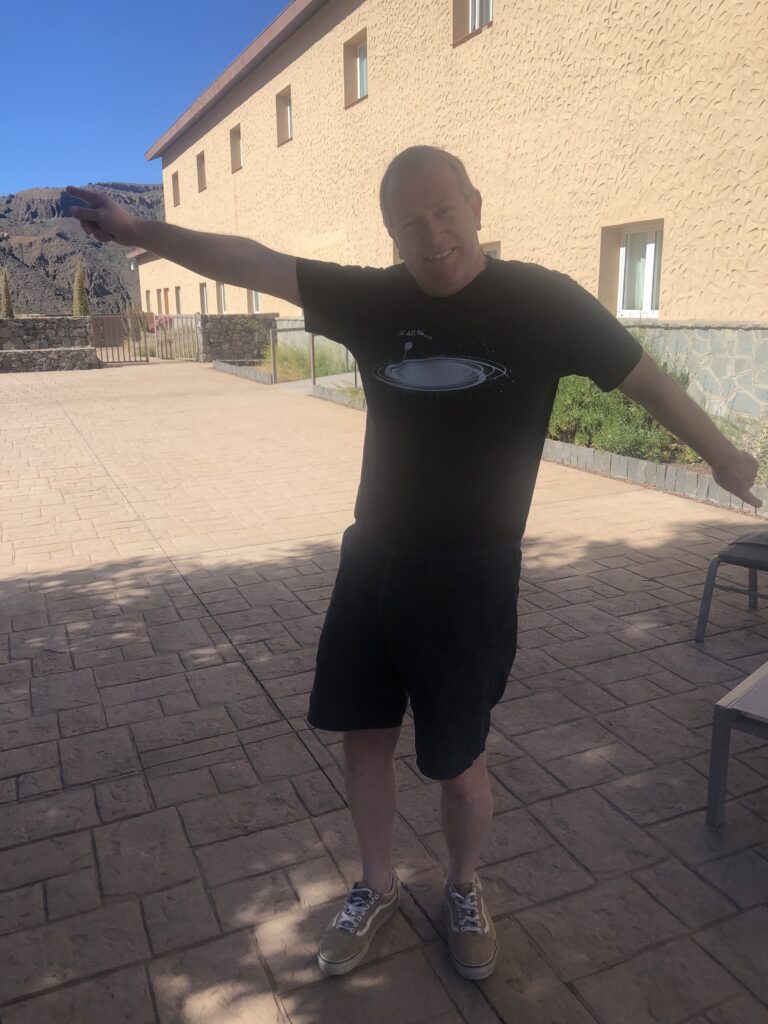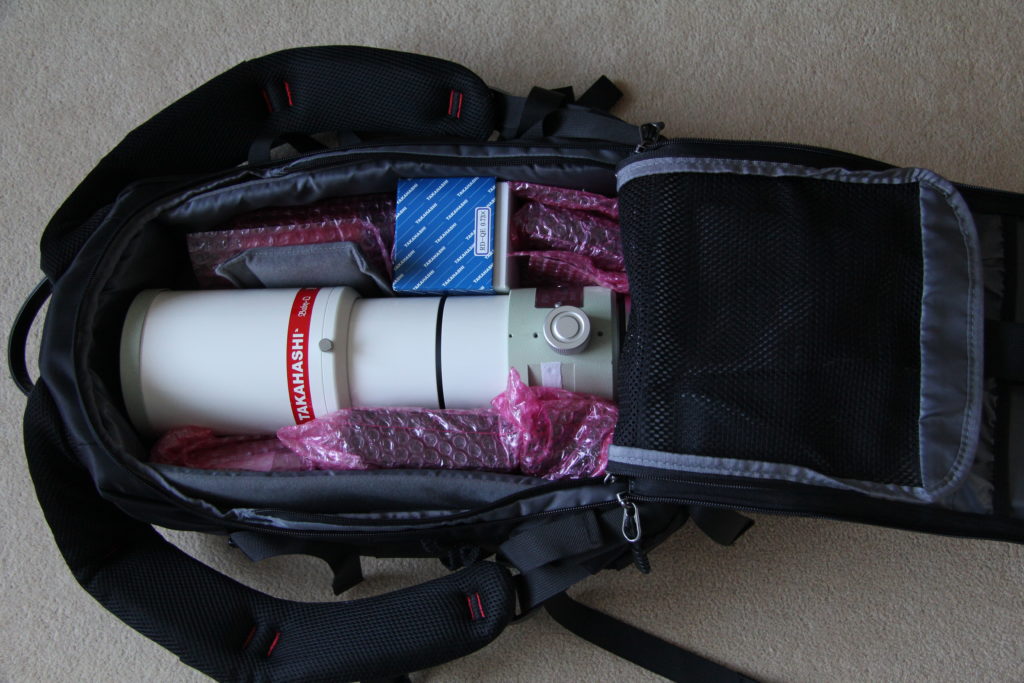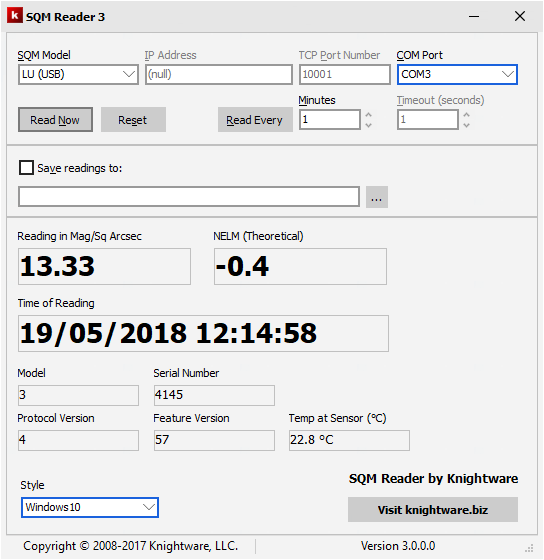The group has just returned from the 2023 expedition to Mount Teide and the Parador. We have already booked next years trip back to the Parador and the wonderful staff who really our stay comfortable.
Category: Tenerife
Tenerife 2023 Expedition Booked
So BASEG have recently booked our flights and hotel accomodation for our Tenerife 2023 Expedition. We now have a grand total of 11 participants and as long as the world does not have a repeat of global ‘Human Malware’ epidemic or a deranged lunatic doesn’t try to blow the world up then we will going to Mount Teide for Astronomy/Astrophotography.
Quite of few of the group have been purchasing Harmonic Mounts (ZWO/Pegasus) in an attempt to reduce their travelling weight. It will be interesting to see what scopes are used on the mobile mounts …. interesting times.
Tenerife June 2022 Expedition

After a hiatus of over 2 years due to COVID-19 and the ensuing pandemic, a group of 6 amateur astronomers have made it out to Tenerife. Alan Lorrain, Bob Trevan, Ian Piper, Mark Radice, your truly Dave Shave-Wall and newcomer Lawrence Saville.

Staying at the Parador hotel, situated just below the base of mount Teide at 2,158m (7,057 ft), with stunning views of the mountain towering an additional mile above our heads.
This trip was the first time more than a couple of us were staying at the Parador, due to not wishing to travel the hour up and the hour down the mountain every night and morning. Also we had been unable to make contact with the MONS telescope personnel at the observatory and the website no longer worked to allow bookings, so we were in need of accommodation, facilities and power.
The Parador seemed like the perfect choice.

We took a sensible flight out to Tenerife with BA at 1:25pm on Saturday, with their generous baggage allowance, most of us opting to fly Business due to the manageable cost which included an upgrade of the allowance from 1 x 23kg to 2 x 32kg checked luggage and the additional 23kg carry on plus an additional allowance of a laptop of 23kg! A couple of us including myself booked 2 further bags as we were carrying heavy equipment.
In hindsight we would look to travel on a different day next time due to the volume of travellers flying from T5. The BA lounge was great and a welcome retreat from the hustle and bustle of the concourse just outside. We took off slightly late and then arrived 4 hours later due to the headwind all the way and it was indeed a pleasant flight.

We then went through a quick security check including for our health check verification which we had completed on the SPth site prior to arrival and then waited for our bags. This turned into a lengthy stay of over an hour at the airport and then the realisation that some of our bags were still in London! So with slight annoyance and heavy hearts we set off to Cicar to collect our vehicles and head up the mountain.
The following day Lawrence and I took a trip down to the airport and were reunited with our bags sitting amongst the 50 or so that had made the trip that morning. The route back up the mountain is now our favourite with very few twists and turns and only 1 hour in duration. You take the TF-1 West out of the airport, stopping briefly at Lidl for supplies, then all the way up to Los Gigantes and then take a right, briefly following the TF-82 heading to Chio before turning left onto the TF-38. We follow the TF-38 for about 30km to the T-junction with the TF-21, turning right for the last 7km to the Parador.

Dinners at the Parador were superb, the selection was good, the quality amazing and the portion sizes were large. We were all fairly stuffed after 1 hour of eating by 9pm in time to setup in the evenings, which took place out the back of the hotel in the relative darkness by the indoor pool building.
(Dinner)

The Parador hotel could not have been more accommodating, they moved Bob to a new room to facilitate coming out of the lifts and getting to his room without the need to traverse the stairs. The laid out extension leads for us to various places around the patio to the rear of the hotel where the pool resides. They even turned off all the lights, closed curtains in the restaurant early and left various doors open for us to enter when we needed. They were simply wonderful!

So what was the the site like for observing? Well whilst we thought the southern horizon was going to be a problem I was observing Omega Centauri at +02 deg altitude at 11:30pm! So pretty amazing. There were various places to setup, most of us choose the corner of the patio area away from the pool building and where several piers were located.
Some setup down by the pool are also and again several piers were located there also.




The piers can be booked, in case someone does turn up with a booking, through Klaus Peter Schröder, email Klaus-Peter at kps@astro.ugto.mx
An interface plate needs to be made so the first visit would require taking measurements of the top plate to marry the interface plate to. Bob made up a plate before arriving for his Tak mount which worked a treat.
I now have good templates for each of the pier tops if anyone would like an interface plate making up … Bob



The EM-2 and Sky90 was left tracking Venus so we could observe Venus during the day. We successfully did a meridian flip and reacquired Venus and then attempted to find Jupiter during daylight using the setting circles, but unfortunately failed but were able to re-acquire Venus.
The seeing was mixed during the week. The first night was average, the second night much better, nights, 3 and 4 were varied throughout the night. Some of use took 5min subs and others 30s or 2mins. What we found was taking shorter exposures allowed us to discard those frames where the seeing was poor and retain those where the seeing was excellent.

One evening we took a trip by foot to the the caldera where we used DSLRs to take skycape’s, a welcome break from either visual observing or telescope imaging. A variety of objects were seen and imaged and we had a lot of fun with the different rock formations. A favourite was the actually the church on the way back to the hotel.

Many of us came sporting astronomy T-Shirts, Lawrence kept surprising us by showing off his cool ones we had not seen before. What a geek!

Nights were long which was splendid and days were longer. This gave us time to process images, relax on the patio and have a beer.

So would we recommend the Parador for an astronomy holiday? Absolutely! Will we come back for BASEG 2023? I think we know the answer to that 😎
BASEG member articles in Astronomy Now
Two articles written by BASEG members have been published in the September 2018 edition of Astronomy Now and includes images by another member :
- Observing In Paradise
- The Solar System In One Night
The processing begins
Now we have returned from the Tenerife trip, sorting through the data accumulated, in my case some 0.72 Terabytes, starts. Most of the data comes in the form of movie files for the Moon and planets through the MONS telescope. The rest is a mixture of deep sky objects and a small portion of night time shots around the observatory. An example is this shot taken from the ridge overlooking the observatory.

So what types of image am I processing right now? Well here is one I processed in the past few weeks whilst I start to work on some shots of Mars. This is an image of NGC 7023, the Iris nebula. What you are looking at is a reflection nebula, containing dust and gas which has it’s electrons excited by the star within. The rest of the image contains a lot of stars and a huge amount of Interstellar Flux Nebula, pervading clouds of dust within this region of space.

So I will go back to processing some more images and see if I can crack through the 10s of images yet to come from our successful week away.
Tenerife9 2018 Session Ends Early – Saharan Dust Stops Play
The group has had to bring the session to an early close due to the Saharan dust levels wiping out the sky quality. Known as the Calima, hot winds from the East bring Saharan dust across to Tenerife which destroys the sky quality needed for deep sky imaging.
We monitored the SONG (Stellar Observations Network Group) weather page throughout the week to assess our chances at clear sky imaging. When the red level is breached then the resident telescopes at Teide close their domes. For our purposes we were looking for dust levels around 0.001 which is below the yellow line.

Before the Calima arrived the SQM was measured to be around 21.68 mag/arc sec2 (Bortle class 4) compared to around 20.5 (Bortle class 4/5) in the UK local area. Bob’s image also shows the visible layer of Calima dust :

It was a good week for all regardless of the common issues many of us encountered that stopped initial imaging attempts but once into the groove some nice images started to appear both for the portable deep sky imagers and those using the Mons Telescope for spectroscopy and lunar/planetary imaging (Mars/Jupiter/Saturn/Neptune/Uranus).

We would like to extend our gratitude to the IAC for allowing us to the use of the Mons Telescope and the associated facilities ….. gracias amigos 🙂
Packed for Tenerife9 2018 Trip
July 2018 sees another trip to Tenerife with friends from the Basingstoke Astronomy Society Exped Group. I had such a great time last year I can not wait to return again….Super excited.
From Tenerife, the planets will be high in the sky, the summer milky way will be glorious and there are a reasonable hours of darkness (unlike home where it isn’t getting dark at all!). Not only is the site perfect for observing (assuming it is dust free) we also get use of a 20” f15 cassegrain and facilities such as a warm room (table, chairs, kettle), outside electricity to power equipment and access to a toilet. A pleasant change from being in a layby on the hillside.
A solar system full house
I am really excited to be able to observe the planets. Being located in the far southern sky for some years to come the major planets are out of sight from my observatory, hidden behind nearby trees. The major 3 will be well placed: Jupiter, Saturn and Mars*. In the evening sky, Venus and Mercury are visible and in the morning sky Uranus and Neptune are returning.
I am wondering if it will be possible to observe all major bodies of the solar system in one go? The planets are all well placed – plus there is the minor planet Ceres, asteroid Vesta, the crescent Moon, solar observing during the day, zodiacal light, the moons of the outer planets – and in the foreground we have earth’s Mt Teide (the highest mountain in Spain). Faint Pluto is possible but at mag 14 it will be a challenge. I have observed it with the 20” dobsonian at Les Grange in France so assuming I can star hop (which is a challenge as the telescope can be rather ungainly) it should be visible. There are is also a relatively bright (mag 10 or so) Comet 21P Giacobini-Zinner that we can track from night to night.
Equipment
A key question is what equipment to take. We have access to a telescope which is fantastic for observing the planets but it is always well utilised by the group. While I would love to fill my boots it wouldn’t be fair to use it exclusively so I am taking my 6” Maksutov and a tracking mount (all second hand) along with my binoculars, camera, eyepieces, sketching equipment etc. I paid extra for my flight so I can take a hand-carry suitcase. This means I can take all my delicate optics with my in the cabin while the heavier, more robust tripods, extension cable etc can go in the hold.
This means I can be:
- Observing inside the dome when it is free
- Using my 6” telescope in the meantime
- Chilling out with my binoculars in the summer milky way
- Taking wide field shots and timelapses
I made a video of the set up I am taking and how it all fits into 2 suitcases below :
A report and video of the amazing sights we saw last year is also below
* Jupiter is just past opposition (it was at opposition on 10 June) with Saturn only a week past opposition and Mars nearly at opposition (it reaches opposition on 27 July just after we return).
New kit for upcoming trip to Tenerife
After a couple of trips to Tenerife with my Canon 5D Mkii, Canon f2.8 200mm prime lens on an AstroTrac as my main imaging kit, I’ll be adding a Takahashi FS60-CB with a flattener and an ATIK Infinity Mono camera to the mix.
Recent imaging for the dstl Project Argus has helped resolve adapter issues with the FS60 / Canon DSLR combination as it is a FS60 special and not a regular Wide EOS adapter that is required. Live broadcasting to YouTube will also be a new possibility this trip with the ATIK Infinity camera.
Preparing for my first Tenerife trip
So since I don’t have a mobile setup like the veterans of the group I’m resigned to fact that I need to take most of my UK setup with me abroad. This means some serious weight to transport, so basically I have the following to pack and carry :
- Hold bag1 (~18Kg)
- Skywatcher NEQ6 mount
- Hold bag2 (~18Kg)
- Skywatcher Tripod (7Kg)
- Counterweight (5Kg)
- Box of accessories (~6Kg)
- PSU, cables etc
- Clothes …. I guess
- Cabin bag1 (~7Kg)
- Tak FSQ85
- Tak focal reducer
- Atik 460 CCD imaging camera
- Lodestar guide camera
- PoleMaster camera
- Lakeside focuser control unit
- Unihedron SQM
- ADM Scope plate
- Cabin bag2 (~6Kg)
- Atik EFW2 and filters
- Laptop & NUC
- Various digital items (GPS, USB hard disk etc)
- ADM mount puck and scope rings
Hopefully the scope bag will in in the overhead with it’s precious contents….don’t drop it ! The laptop bag should fit under the seat….hopefully.

I won’t be sure on the final weights until the digital handheld scales I’ve ordered arrive tomorrow.
At the moment I’m just finishing the calibration and setup of the Lakeside focuser and it’s configuration in SGPro.
Update : The digital scales arrived so now I have weights for a few items and move things around a bit –
- Hold Bag1 = 19.3kg
- Hold Bag2 = 22.5Kg
- Cabin Bag1 = 8kg
- Cabin Bag2 = 8.85Kg
Sky Quality Meter
So I recently received from First Light Optics (FLO) the Unihedron Sky Quality Meter (SQM-LU) USB device. The box contained the SQM-LU device, a 2 metre USB cable, CD containing all the necessary software, a hard copy of the user manual and a calibration report.
 The device was already factory calibrated and was shipped with latest firmware. The Unihedron Device Manager (UDM) is the standard way to access the device and provides all the necessary options for a simple plug and play experience.
The device was already factory calibrated and was shipped with latest firmware. The Unihedron Device Manager (UDM) is the standard way to access the device and provides all the necessary options for a simple plug and play experience.

The device can also be connected to a GPS device via the configuration tab to get the location and time so it can be written to the data headers. Measurements can be written on a configurable interval and the file can even be transferred to a remote machine via FTP or SCP (not tested yet). There is even a simulation mode for when you want to just test the device during the daytime.

The log file structure and protocol is well documented shown above but summarised below
# UTC Date & Time, Local Date & Time, Temperature, Counts, Frequency, MSAS, MoonPhaseDeg, MoonElevDeg, MoonIllum # YYYY-MM-DDTHH:mm:ss.fff;YYYY-MM-DDTHH:mm:ss.fff;Celsius;number;Hz;mag/arcsec^2;Degrees;Degrees;Percent
There are included examples on the CD showing how to connect the device directly using various languages such as Python and via a RaspberryPi. There is also a freeware program SQM Reader3 with basic functionality that can be used instead of UDM, they also produce a more fully functional program (SQM Reader Pro) at a cost.

There is a third party ASCOM driver that allows integration with imaging automation software such as SGPro via the ASCOM Observing Conditions Hub

and this value is written directly to the FITs header (SKYQLTY field) of your acquired image.
This device will of course will be joining us on the trip to Tenerife so the measurements can be provided to all and sundry.
